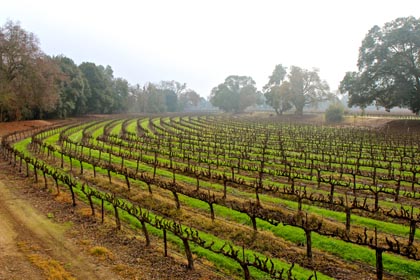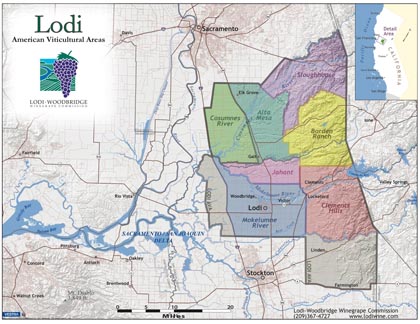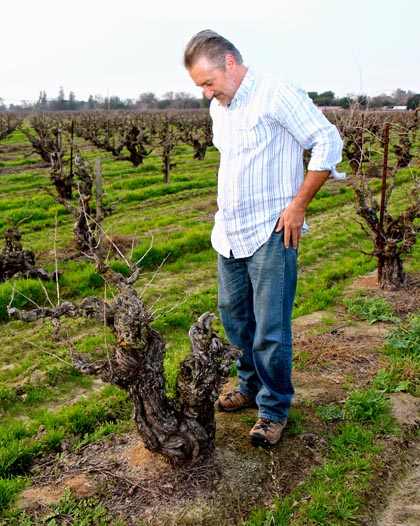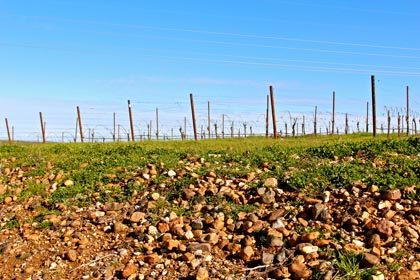Letters from Lodi
An insightful and objective look at viticulture and winemaking from the Lodi
Appellation and the growers and vintners behind these crafts. Told from the
perspective of multi-award winning wine journalist, Randy Caparoso.
The expansion and controversial division of the Lodi Viticultural Area
Trellised vines along Lodi's Mokelumne River
Continuation of a Part 1: The origins of the Lodi Viticultural Area
In 1991, some 600 Lodi AVA growers came together to form the self-mandated Lodi-Woodbridge Wine Commission (now called the Lodi Winegrape Commission) for the purpose of regional promotion, education and viticultural research. This would be a momentous development, playing a crucial role in Lodi’s current status as a winegrowing region of note.
In an effort to reconcile the then-existing boundaries of the Lodi AVA with the jurisdiction of the Lodi-Woodbridge Wine Commission as well as how California Crush District 11 defined Lodi, in 2000 a petition was submitted to the ATF to expand the Lodi AVA on its west and south sides by 93,500 acres, which at that time included an additional 9,240 acres of planted wine grapes.
The second, expanded version of the Lodi AVA was approved in 2002. In the approved petition, the climate of the additional areas was described as having "the same moderating influences of the Sacramento Delta (i.e. Sacramento-San Joaquin River Delta) winds that define the current boundaries." Plus, the "soils of the proposed expansion area are substantially similar to those of the existing viticultural area" – derived "mainly from mixed mineral alluvium, products of weathering, erosion and deposition along the western slope of the Sierra Nevada."
But some Lodi growers and vintners felt that they were still not yet done. With the entire AVA in an explosive, steady growth pattern since the late 1980s, there was a need to delineate the flatter, historic winegrowing region around the town of Lodi from the hillier or terraced regions located in the eastern and northern sections of the AVA.
Lodi American Viticultural Areas
In 2005 a group called the Lodi American Viticultural Areas (LAVA) Steering Committee submitted a new petition to the TTB to establish seven new sub-areas within the boundaries of the existing Lodi AVA, based upon distinctions primarily having to do with differing soils and topographies, with additional evidence for historical usage of the names of the proposed new AVAs:
Markus Bokisch with Zinfandel in Mokelumne River AVA’s fine sandy loam
The petition to establish these seven additional viticultural areas falling within the broader Lodi AVA was approved by the TTB in August 2006.
According to Bokisch Vineyards' Markus Bokisch, who initiated the push for sub-AVAs with Lodi grower Keith Watts, "The process began when Keith and I became interested in highlighting the differences of the volcanic soils that define the Clements Hills area with surrounding areas in the Lodi AVA." The group consulted with many longtime Lodi growers, and hired Deborah Elliot-Fiske, a Professor from U.C. Davis, to help sort out climatic and soil characteristics in unimpeachable scientific fashion.
The question many people, inside and outside the wine industry, are still asking is, what was the purpose of carving up the Lodi AVA into seven more regions – to confuse consumers even more? While acknowledging that there was some opposition to the concept of sub-regions in the Lodi winegrowing community, Bokisch contends, "The story that Lodi is not monolithic needed to be told."
Alleviating fears that usage of sub-AVAs might weaken the significance of seeing Lodi on a bottle label, Bokisch adds, "At the core of our proposal was conjunctive labeling" – meaning, the requirement that the name of a sub-AVA be placed alongside the name of the larger AVA. For example: "Clements Hills-Lodi," or "Jahant-Lodi."
No one is required to utilize any AVA whatsoever on a label. Wine producers still have the option of putting just "Lodi" or even "California" on a wine grown entirely in, say, Clements Hills or Jahant – and many of them do exactly that. The only requirement is that at least 85% of any American wine must come from the place name indicated on a label.
Truth be told, yays and nays are continuously voiced about the proliferation of sub-AVAs wherever it occurs; such as for Napa Valley (divided into 16 sub-AVAs), Sonoma County (crisscrossed by 16 AVAs), Paso Robles (11 recently approved sub-AVAs), and many of the other 227 or so American Viticultural Areas recognized so far.
In future lodiwine.com blogs, we will delve deeper into Lodi's smaller AVAs by presenting some of the vineyards and wines produced in each of them, and you can be the judge as to how meaningfully they truly are.
Bokisch's Vista Luna Vineyard: whereas as there are no rocks or elevated hills to be found in Lodi's Mokelumne River AVA, Lodi's Borden Ranch AVA is all about cobbled clay-loam, terraced slopes.



